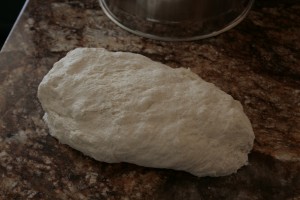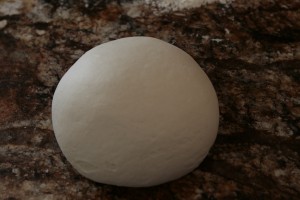Recipe: Neapolitan Pizza Dough
Note from Peter: I’ve been receiving a lot of requests for a proper VPN Napoletana dough. I’ve posted this previously on the Forno Bravo site, but wanted to be sure I also made it available here on PizzaQuest — especially in light of Brad’s recent post on making Margherita pizzas in two different ovens. Enjoy!!
A true Naples dough uses only flour, water, salt, and yeast. Some versions substitute sourdough starter for the yeast and some use a combination of both commercial yeast and natural starter. But this version is for yeast only (I recommend instant yeast). Also, it is customarily made with Italian -00- flour, of which there are a few brands available. Caputo is the most well known brand but now there are also American brands, such as King Arthur and Central Milling, who make their own version of this flour. Double Zero (-00-) means that it has been sifted fully to leave behind only the pure endosperm of the wheat, and typically uses a somewhat softer wheat than what we know as bread flour — more like all purpose flour, mixed with a little pastry flour, so that the gluten content is closer to 9.5% to 10%. But even this may vary because -00- doesn’t really refer to gluten, just to the purity of the grind and sifting. For this reason, any recipe can only give an approximation of the water content, depending on which brand of flour you use. You will have to adjust when you make it based on the feel of the dough. It shouldn’t be sticky, but it should be very supple and also tacky to the touch. The following recipe is based on the one from American Pie: My Search for the Perfect Pizza (Ten Speed Press, 2003). It will make five 8-ounce doughs (227 g), or six 6-ounce doughs (170 g).
5 cups unbleached all purpose or -00- flour (22.5 oz / 638 g)
1 3/4 teaspoons table salt (0.43 oz / 12.5 g) (if using coarse kosher salt it will be closer to 2 teaspoons)
1 teaspoon instant yeast (0.11 oz / 3 g)
1 3/4 cups plus 2 tablespoons cool water, 65º F (15 oz / 425 g)
- Mix all the ingredients together in a large bowl or an electric mixer on slow speed (use the paddle attachment) for about 1 minute. Let the dough rest for 5 minutes. If using a mixer, switch to the dough hook, then continue mixing on second speed for about 2 to 4 minutes, or until the dough is smooth and supple. Add flour or water if needed.
- Transfer the dough to a slightly oiled work surface and hand knead for an additional minute, making any final adjustments. The dough should be tacky but not sticky and feel very supple, not stiff. Cover the dough with a bowl and let it rest for 30 minutes.
- Divide the dough into desired size pieces and form each piece into a ball. Place the dough balls onto a lightly oiled pan or into a dough box. Mist with pan spray and cover with plastic wrap, a large plastic bag or trash can liner, or a lid. Place the pan into a refrigerator to slowly ferment overnight. (Note: if making pizza on the same day, allow at least 6 to 8 hours in the fridge). They will keep in the refrigerator for up to three days. (You can also refrigerate the whole dough, in a covered bowl or container, and divide and ball it the next day, two hours before you plan to make the pizzas).
- Remove the dough balls from the refrigerator 2 hours before you plan to bake the pizza to take off the chill and make them easier to stretch. (Note: You can also freeze the dough balls by placing them each in their own freezer zip bag that has been misted with spray oil. They will keep for up to three months. Move them to the refrigerator the day before you plan to make the pizzas to slowly thaw, then treat them as refrigerated dough the next day).
After that it’s all about the pizzas. Crank your home oven up as hot as it will go, preheat the baking stone for at least 45-60 minutes, and make your favorite version of Margherita or any Napoletana pizza.
We’d love to get your comments on this (below) as well as any photos you’d like to share. Send the photos to us at info@pizzaquest.com and we’ll add them to our media library and post the best ones.
May your pizzas all be perfect!!!
Peter
Recent Articles by Peter Reinhart
- Peter Scott Ruben: Why Frank Sinatra is the true “Chairman of the Board,” and the Greatest of the Greats
- Elizabeth Brasch, Mellow Mushroom’s Has a Vision
- Nipun Sharma: Pizza’s A-I Robotics Future is Now
- Maui Pizza with Chef Jeff Scheer of Restaurant Marlow
- The Pizza Yodi’s Are Back –John Arena and Brian Spangler are in the House!
- Arthur Bovino and Alfred Schulz and Their Pizza Pod Party
Add Comment
You must be logged in to post a comment.














That’s a nice recipe, with minimum yeast and a long slow fermentation. It just proves that there are so many ways to make excellent dough. Thanks, Steve!
I have a dough box and in step 3 I have always placed the dough balls in a lightly floured dough box and lightly floured on top. SHould I be lightly oiling the tray instead and misting the tops of the dough balls with pan spray before putting the lid on top ?
I wouldn’t oil the box — sprinkling with flour may be sufficient. If the dough sticks to the box you can mist it with pan spray, but you don’t want oil on the dough surface, especially if baking in a wood-fired oven where the oil will smoke when it hits the hot deck. As with many things, if it isn’t broke you don’t need to fix it.
Thank you Peter !
Hi Peter
Thank you for sharing this recipe. It is quite a bit different that what I use for Caputo Pizzeria 00 flour. I follow what is on the Caputo website, which results in a 60.1% hydration vs 66.6% for above. There is also a reduction in salt and a significant increase in yeast. I have a wood fired oven I can get to 900+ temp. Would the above recipe be interesting for the Caputo flour? I would like to get more rise in the dough and be more delicate overall.
Than you, mike
Thanks
Hi Mike,
I think my recipe with Caputo flour would be too wet, as it doesn’t hold as much water as American bread flour. There are so many subtle tweaks that all fall within the realm of “legitimate” that I can’t say yay or nay to any idea, so I just say, try out your theories in a small batch and see what happens. I can’t vouch for anyone else’s recipe, just my own, but I’m sure there are great recipes by others that work really well. Please keep us posted as you try out your test bakes; who knows, you might tweak your way into a breakthrough worth shouting about!